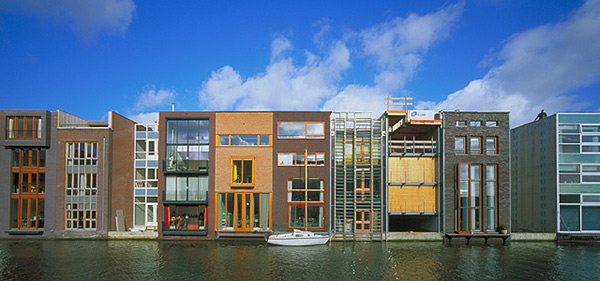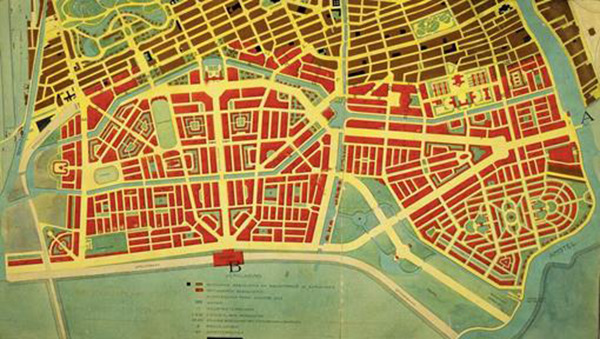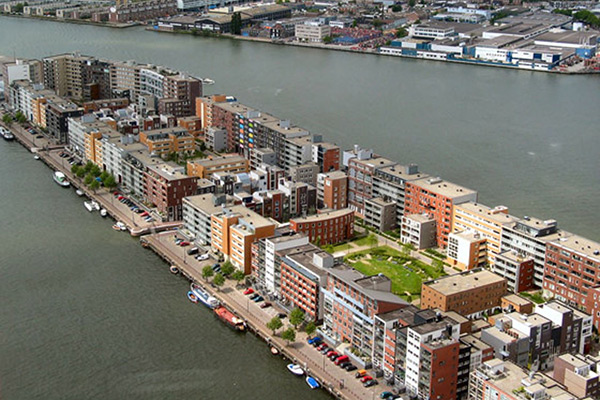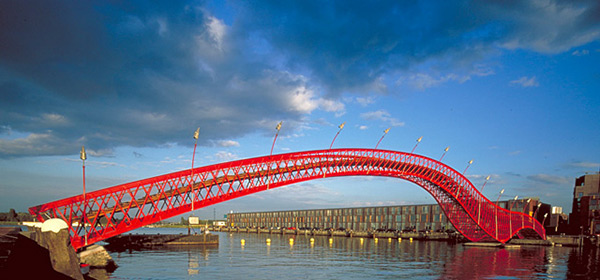An architectural critique of this high density housing area.

Amsterdam Borneo Sporenburg development. Photography by West 8 Urban Design and Landscape Architecture.
Amsterdam’s history
The city of Amsterdam is quite known for its unique picturesque architecture. The Dutch first used wood as a prime material in construction building but in the 16th Century most of it was demolished and replaced by brick buildings. The city developed as a result of conscious planning. The canals’ plans were settled in the early 1600’s to simplify the overseas trades and the immigration peak. The canals followed a four “U-shape” design, from west to east, improving the city’s accesses, water management and security. It was Amsterdam’s Golden Age; an innovative, powerful, rich country emerged.
The architect Hendrick de Keyser spurred the development of the Renaissance architecture style adapting it to the city’s local features. In this period the city-centre houses were high and narrow, the pitched roofs were extremely steep and, following the identical design, there was a triangular steep gable over the windows and front doors. The architecture kept invested in the Italian Renaissance and Mannerist styles until the Roman Baroque style took over.
In the 18th Century, with the Napoleonic Invasions, Amsterdam ceased its expansion beyond its borders for two centuries; however, the 19th century brought big changes: new residential suburbs burst beyond the ring’s central canals. In the beginning of the 20th Century Hendrick Berlage designed the Plan Zuid, or South Plan, developing the south area between the rivers Amstel and Schinkel. This plan consisted in straight narrow streets and long blocks (50 x 100m), intersected by several broad axes.

South Plan as adopted in 1917 by the City of Amsterdam
In 1930 the Department of Public Works conducted a master urban plan known as the General Extension Plan of Amsterdam. By 1966 a large section in the south east of Amsterdam was incorporated into the city: the Bilmer Area. The city continued its expansion and by 1990 the Eastern docklands of Amsterdam start sprawling.
The 1999 Master Plan
In 1999, West 8 designed the Master Plan Borneo-Sporenburg, two peninsulas surrounded by the docklands. The programme sought for 2500 low-rise residences, aiming for a 100 units per hectare. About high density housing, West 8 had as examples the nearby KNSM and Java Islands. The first, designed by Jo Coenen, a massive scaled plan with a long central avenue bordered by large superblocks of housing; and the second one, designed by Rudy Uytenhaak, a more domestic scale allowing inner courts and public gardens.

KNSM Island, named after the Koninklijke Nederlandse Stoomboot-Maatschappij, the Royal Dutch Steamboat Shipping company which historically had its headquarters and its docks on the island. Photography by de Architect, Jo Coenen.
Java Island
The Java Island’s example was more in tune with the West 8 ’s idea. They confined the high density of the program into a suburban area, mostly inspired by the Dutch canal houses of “De Jordaan” but with a twist; they developed a fixed typology of three-storey, ground accessed houses, granting façade rhythm by the variation of blocks and open spaces designed by a considerable number of well-known Dutch architects like MVRD, UN Studio and OMA. They also switched the ordinary Dutch terraced canal houses for a more private configuration with the creation of patios and roof gardens. Each architect made their own design approach, creating diversity that worked as a unified whole, providing a sense of character and exciting environment since the beginning.
The balance between these 3 storey-high houses and its surroundings is interrupted by 3 massive sculptural blocks that take place as landmarks, providing the required density. The “PacMan” and the “Sphinx” are set transversally to break up the linear monotony of the units. Higher than the surrounded houses, this buildings focus on themselves, integrating public gardens and interior courtyards, providing a sense of domestic scale for those who inhabit them. A large diagonal green corridor also dismantles the ruled repetition of the urban grid providing a fresh void into the plan.
The Python Bridge

Python Bridge, connecting Sporenburg and Borneo Island in Eastern Docklands, Amsterdam, built 2001 by West 8.
Urban Design and Landscape Architecture. Photography by West 8.
The 2 red stainless steel bridges connect both sides and play an essential role in the master plan creating a unique picturesque environment due to its organic form and colour. The plan encourages cycling and walking; there are only a few spaces available to park in the streets, it’s mostly internal or underground. The two bridges are strictly for pedestrians and cyclists: one low and the other one, “the Python”, waving steeply enough to allow sailboats’ access to the marina.
Ana’s summary
A masterplan with not only a strong respect for Amsterdam’s architectural heritage but also fresh contemporary vision; following the city’s culture of equality, tolerance, and acceptance, playing a huge role balancing social disparities that so often occur in this kind of high-density new housing areas with no identity, nor a sensitive sense of the inhabitants. Borneo- Sporenburg: the Venice of Amsterdam; the houses touching the water, the reflections over the canals absorbed by the living environment, the intimate scale but still the characteristic big landmarks that bring diversity and harmony, becoming a dynamic and interesting new area of Amsterdam.